Treatment of osteochondrosis of the cervical spine uses the latest highly effective techniques, using modern equipment and under the guidance of experienced specialists.
Spinal cord disease can give a person many unpleasant sensations, especially if it affects the cervical area: there is a danger of damage to the spinal cord and brain. In addition, osteochondrosis of the cervical spine often causes headaches, causes dysfunction of internal organs and contributes to the deterioration of blood circulation. Fortunately, today several therapeutic techniques have been developed that allow you to get rid of unpleasant symptoms and restore a healthy spinal condition.
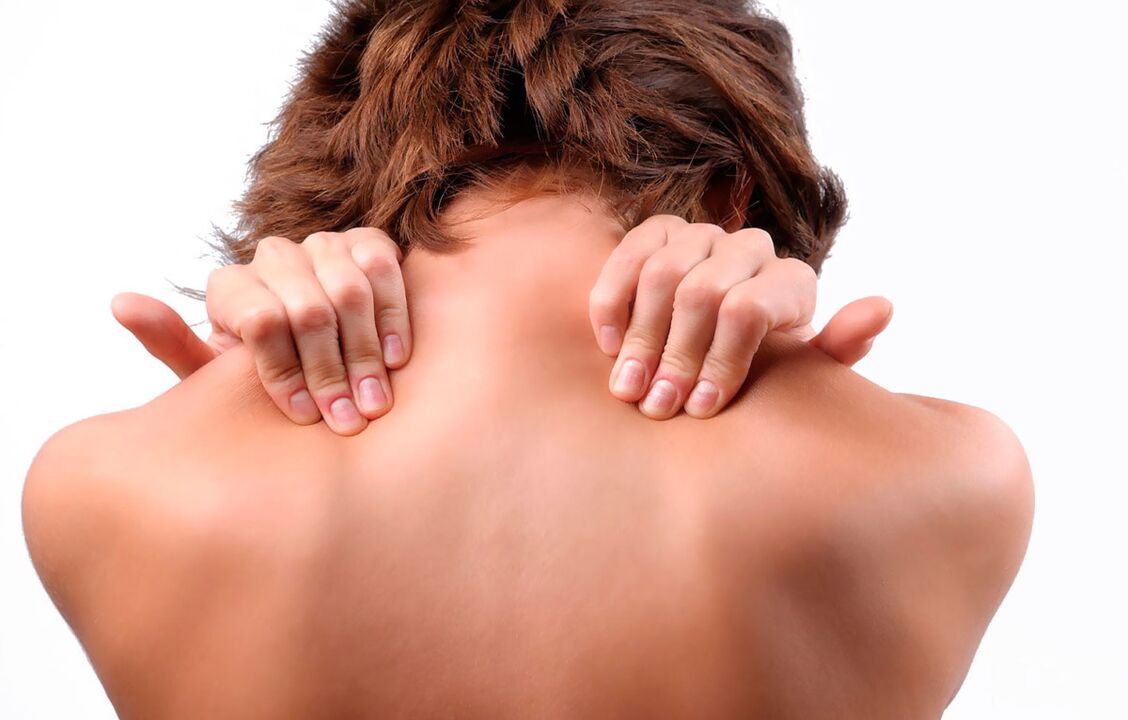
In this article, we will tell you in detail about the characteristics of cervical osteochondrosis and describe the main methods of its treatment. We hope that after reading it, you can choose the most effective method to overcome this disease and be able to avoid radical surgery.
What is cervical osteochondrosis?

Cervical osteochondrosis is a disease in which the soft pulp increases, which serves as a protective function between the vertebrae. At the same time, blood vessels and nerve roots are involved in the mechanism of development of the disease.
A hallmark of osteochondrosis of the cervical spine is the occurrence of pain in the shoulders, occiput, neck and head. In addition, patients noted the appearance of dizziness, increased blood pressure, oxygen starvation, loss of sensitivity on one side of the tongue, and other symptoms characteristic of cardiovascular pathology. This becomes a reason to contact doctors with other specialties and significantly slows down the disease diagnosis process.
Often, people from the middle-aged and older categories are prone to tissue oxidation of the upper part of the spinal space. This is due to the incorrect distribution of dynamic and static loads on the human skeleton.
However, if previously cervical osteochondrosis and thatsymptomsdiagnosed in people older than 45-50 years, but now the age of patients suffering from this disease is much younger. Today it affects young people aged 20-40 years, which is associated with a decline in diet and physical inactivity.
Currently, there are two approaches to cervical spine problems: it is considered a combination of physiological and pathological factors. In the first case, we are talking about the aging of the body under the influence of inevitable natural phenomena, in the second, it is assumed that the destruction of intervertebral formations occurs against the background of inflammatory processes and dystrophy caused by improper lifestyle.
Symptoms of osteochondrosis of the cervical spine
The problem with the diagnosis of this disease is due to the absence of pain in some conditions and the nature of the implied symptoms. In addition, a person may not feel any signs of illness while taking strong painkillers to reduce overall discomfort. All of these can cause serious disorders in the cervical joint area.
Among the obvious symptoms of cervical osteochondrosis, causing the need totreatment,include: headache, high blood pressure, frequent dizziness. We will discuss it further.
Dizziness with cervical osteochondrosis

Dizziness may not always appear against the background of problems with the cervical spine. In some cases, this indicates a disorder of the brain, damage to blood vessels and the heart, inflammatory processes in the ears and nasopharynx, the presence of malignant neoplasms or pathological conditions of the nervous system.
Dizziness with cervical osteochondrosis and the need for its treatment may have a non -systemic or systemic etiology.
In the first case, a person may express feelings of mesmerizing, unsure while standing and slightly fainting. At the same time, there is no sense of round rotation.
As for systemic dizziness, then, most often, it is evidence of vestibular disorders, impairment of visual analyzer function and other changes arising against the background of osteochondrosis. In this case, the patient can feel the circular rotation of the body or nearby objects.
If dizziness is present and the patient simultaneously experiences symptoms such as acute pain in the head, numbness in the upper chest, fainting or impaired coordination of movements, he must be immediately hospitalized.
Headache with osteochondrosis of the cervical spine
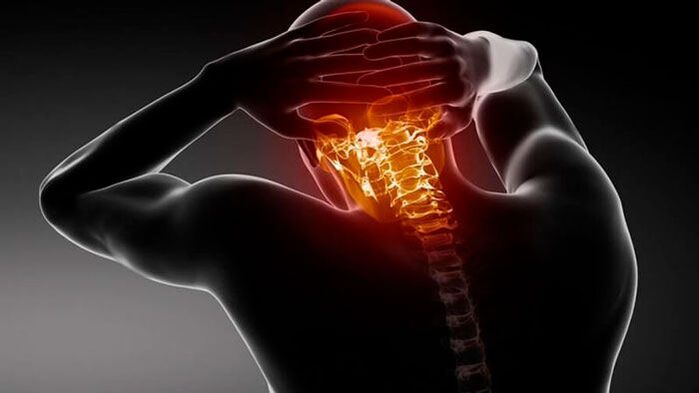
The appearance of a headache can indicate the presence of various diseases. Most often, it occurs in women with a background of hormonal disorders, stressful situations, increased intracranial pressure, spasms in the brain, pinched nerve endings, inflammatory processes and other diseases.
can signal the presence of various types of diseases. Most often, it occurs in women with a background of hormonal disorders, stressful situations, increased intracranial pressure, spasms in the brain, pinched nerve endings, inflammatory processes and other diseases.
Sick andnoise in the headwith cervical osteochondrosis, which causes the need for treatment, is often confused with symptoms of acute disruption of blood supply to the brain, arterial hypertension or coronary heart disease. Often, such symptoms occur in the elderly suffering from the above diseases.
To find out the real cause of a headache, you should consult an experienced specialist. In this case, it is recommended to undergo an ECG and exclude the presence of cardiovascular disorders.
Other localization pain, characteristic of cervical osteochondrosis
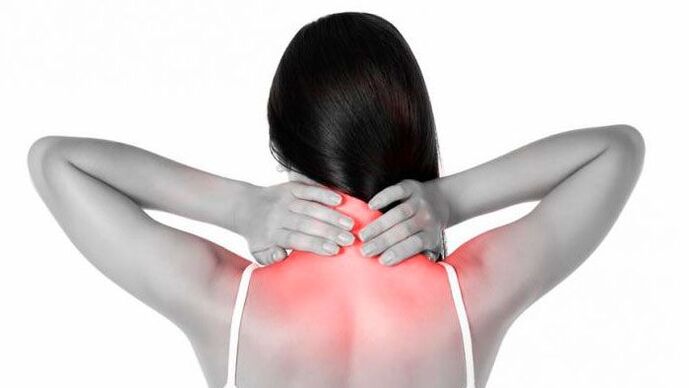
Pain in the back of the head and head is not always a sign of cervical osteochondrosis. In some cases, the discomfort can spread from the neck to the arms and shoulders. Such symptoms are sudden in nature and can occur against the background of sudden movements, after a sharp sneeze, or being in one position during a night’s sleep.
If the cause of the pain syndrome is chondrosis of the cervical spine, then it usually disappears after a certain time or disappears after manual therapy in the cervical spine.
It should be noted that massage in this area is performed only after a thorough examination of the patient. With a non -professional approach, there is a high risk of deterioration of the patient’s condition, including and including his or her disability.
If we talk about osteochondrosis of the cervical spine and the need for its treatment, then the patient notices the following pain sensations:
- The appearance of cramps during rotation of the head;
- The presence of pain syndrome in the neck;
- Decreased sensitivity and the appearance of muscle weakness in various areas of the body.
Blood pressure increases with problems with the cervical spine

Because the cervical vertebrae are directly connected to blood vessels and nerve endings, any disturbance in this area can trigger an increase in blood pressure. However, such jumps are temporary in nature, manifesting as short -term cramps and not a symptom of hypertension.
Also, if there is osteochondrosis of the cervical spine, in addition to increased pressure, the patient may experience other symptoms, and treatment in this case includes the use of special anesthetic drugs. This includes:
- The appearance of pain in the head area;
- Loss of sensitivity in the collar;
- Pain in chest, arms and legs;
- A sudden increase in blood pressure after a stressful situation, prolonged stay in one position, excessive muscle tension and other similar situations.
A strong deterioration in the patient's condition and an increase in high pressure indicate an urgent need to see a doctor.
Stages of development of cervical osteochondrosis
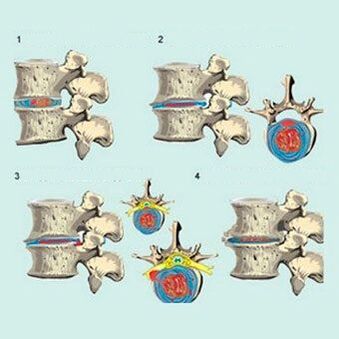
As it progresses, the above disease goes through several stages, accompanied by certain symptoms. We will discuss it in more detail below.
Early stage osteochondrosis
As a rule, if stage 1 disease occurs, the patient may experience only slight discomfort. They can show pain only by sudden movements, tilting and turning the head. Many patients report increased fatigue in the lumbar spine and buttocks, and a persistent feeling of tightness. Treatment of cervical spine osteochondrosis at an early stage does not involve recruitmentmedicines. . . To recover, the patient just needs to dogymnasticswith cervical osteochondrosis and change the daily diet.
The second stage of the disease: features
The second stage of pathology is characterized by a stronger sensation of pain that radiates to the upper part of the leg, and increases by bending and twisting the head. Causes of increased discomfort include: a reduction in the height measurement of the intervertebral disc and, as a consequence, pinching of nerve endings. In this case, the patient noted a decrease in ability to work, the appearance of absenteeism, increased fatigue and the occurrence of pain in the head.
Third degree osteochondrosis
It is accompanied by an increase in pain with irradiation to the upper extremity area, also the shoulders and neck. In this case, numbness in the hand muscles can be observed, which is related to the appearance of an intervertebral hernia. In addition, patients may complain of weakness and severe dizziness.
The last stage of the disease

In the final stages, deep degenerative processes in the area of the intervertebral disc and its replacement with pathological tissue make themselves felt. The need for treatment of cervical osteochondrosisin the stage of deteriorationmay be due to the defeat of some segments of the spine. In this case, the patient noted the presence of tinnitus, increased pain syndrome, the appearance of severe dizziness and impaired coordination of movements.
Causes of cervical osteochondrosis
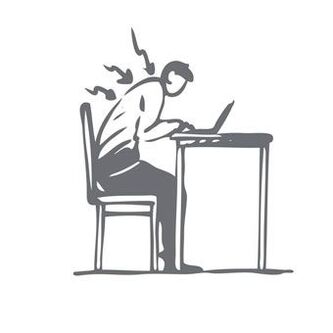
Often, the development of this pathology is due to inactive daily work, in which a person does not control the correct position of the body in a chair, and his head continues to be tilted forward. The same can be said about prolonged head restraints in an inverted state, which is typical for construction specialist workers, when performing repair activities.
As a rule, excessive pressure on the cervical spine inevitably causes degenerative disorders in the area of the vertebral disc. In addition, cervical-vertebral osteochondrosis, the symptoms of this disease and the need for its treatment may be due to the following factors:
- Violation of calcium metabolism;
- The cause of genetic traits;
- Thermal irritants;
- While practicing extreme sports (treatment of sports injuries);
- Hypodynamia;
- Long stays a person in one position because of a combination of professionals;
- Obesity;
- Prolonged stressful situations;
- Injuries to the neck and back of the head;
- Autoimmune processes that can provoke the destruction of cartilage tissue.
The transition to a healthy diet and moderate physical activity can minimize the chances of developing osteochondrosis.
Syndrome of cervical osteochondrosis
The syndrome is represented by the simultaneous manifestation of several symptoms of the disease at once. For osteochondrosis of the cervical spine, it is characterized by the following syndromes: vertebral, vertebral arteries, cardiac and radicular. This is about them which will be discussed below.
What is Vertebral Syndrome?
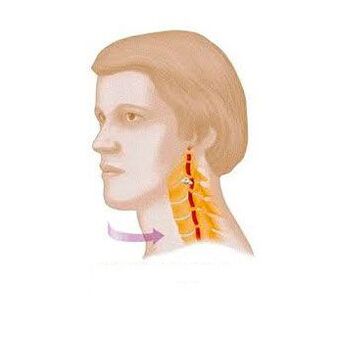
If there is the above syndrome, the degenerative process directly affects the cartilage and bone tissue. In this case, simultaneous manifestations of the following three signs are observed:
- Painful sensation when having to turn the neck;
- Inability to twist the neck;
- The presence of disorders in the intervertebral region or in the vertebral body, which is morphological in nature (to determine these symptoms, X-rays are taken).
If the patient does not have at least one of the above signs, then it does not make sense to talk about vertebral syndrome.
Characteristics of vertebral artery syndrome
The essence of the above syndrome is damage to the vertebral arteries that supply blood to the brain. It is characterized by the manifestation of the following symptoms:
- Against the background of squeezing of the arteries, the patient may feel dizziness, increase in blood pressure, the appearance of tinnitus, nausea, etc . ;
- Because of irritation of the nerve roots, loss of sensitivity, the appearance of "flies" in the eyes, acute pain in the head and numbness can be observed;
- Lack of oxygen can cause severe pain in the head area, excessive drowsiness, decreased activity and decreased concentration.
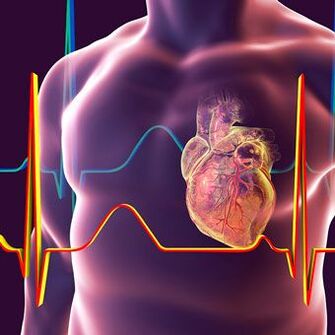
Signs of heart syndrome
In addition to the symptoms of vertebral arteries in cervical osteochondrosis, the need for treatment of patients also arises when there is cardiac syndrome. Many patients report a condition that is characteristic of coronary heart disease, or resembles the symptoms of myocardial infarction. In this case, the following symptoms occur:
- Burning sensation and acute pain syndrome in the sternum area;
- Tachycardia;
- The appearance of severe weakness, excessive fatigue and shortness of breath.
Radicular syndrome: characteristics

It is characterized by deterioration of neuromuscular conduction. If there is radicular syndrome, the patient may lose sensitivity or conversely, severe pain syndrome. Also, its features include:
- Pain in the back of the head or, conversely, numbness in this area;
- Difficulty chewing food, numbness in the area behind the ears, fullness in the tongue;
- The appearance of symptoms of sore throat, hiccups, pain in the clavicle;
- Difficulty moving the upper limbs, discomfort in the shoulders;
- Violations in the forearm area and shoulder blades;
- Loss of sensitivity in the finger area.
Diagnostics
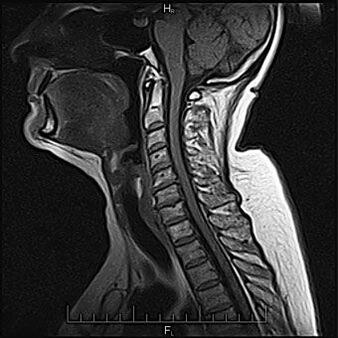
The main and most informative method for diagnosing osteochondrosis includes magnetic resonance imaging (MRI). MRI scans with a high degree of detail reflect the condition of not only the bone tissue of the spine, but also soft tissues - muscles, cartilage, blood vessels, nerves and intervertebral discs. If there are contraindications to MRI (presence of metal prostheses, pacemakers), then computed tomography is prescribed, but the information content of this method is much lower in terms of diagnosis of osteochondrosis.
Is it possible to treat osteochondrosis of the cervical spine?
Regarding cervical osteochondrosis, effective treatment of the disease is possible only with a comprehensive review of lifestyle, ongoing prevention and sanatorium rehabilitation. In practice, only a handful achieve it, especially in the climate of our country, when it is almost impossible to avoid hypothermia and new inflammatory processes. Even so, you can significantly reduce your condition, including in the most advanced cases, and extend the remission period.
Treatment of cervical osteochondrosis

In the first stage of osteochondrosis, patients will be assisted with conservative drug -free treatment. You have to correct your attitude, pay attention to workplace equipment, interrupt work for a few minutes every day to do the uncomplicatedrehabilitation gymnasticswith cervical osteochondrosis, which can be done right on the desk in the office. Swimming, increased physical activity, and intake of vitamins and mineral complexes will have a positive effect on the entire musculoskeletal system.
Advantages of Shock Wave Therapy
If the patient has osteochondrosis of the cervical spine and its symptoms, a new method of treatment is considered the most effective - with the help of shock waves. This procedure is known to be affordable. In addition, if the medical institution has special equipment, you can take a UHT course for free.
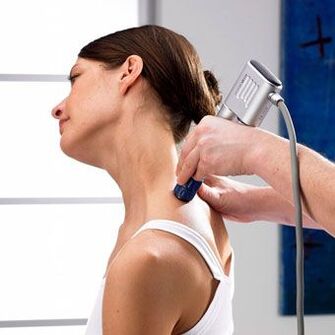
The advantages of UHT include:
- Maximum efficiency;
- Lack of discomfort during the procedure;
- Minimum possibility of side effects;
- Reduce the need for invasive treatment
- Reduce the need to take medication.
Remedies for cervical osteochondrosis
If you have cervical osteochondrosis and are interested in seeking treatmentmedicineandeffective,you can find information on suitable medications on the Internet. However, despite the wide variety of medications and the lack of prescriptions, self-medication is not recommended. A large number of drugs have side effects and contraindications, it is also important not to overdose.
Nonsteroidal anti-inflammatory drugs (NSAIDs).They are used to relieve swelling and pain.
Muscle relaxation, sedation
They are prescribed as a supplement to alleviate the general condition of the patient and reduce the dose of NSAIDs. By relieving muscle spasms and nerve tension simultaneously, you can achieve the best therapeutic effect.
At the end of treatment, doctors usually recommend buying non-steroidal anti-inflammatory medications for first aid at home, as pain in the neck can return when the weather changes, excessive excitement, and stress.
Physiotherapy approach
In cases where drug therapy is contraindicated or does not give the desired effect, and sometimes for complex effects, physiotherapy methods are used, which are available in classical and alternative medicine. They are all intended to relieve muscle cramps, inflammation and pain.
Acupuncture. The essence of this method is to "awaken" the biologically active point by inserting a special thin needle into it to a depth of a few centimeters. This procedure is painful in itself, but helps relieve pain in the spine. Several sessions are required.

Manual therapy. This method is effective if the patient haspinchcervical spinal cord, appropriate symptoms are diagnosed and the need for treatment is identified. Nerves and blood vessels trapped by deformed vertebrae can be released by stretching the spine manually.
Hirudotherapy (leeches). Relieves inflammation and swelling due to biologically active substances released by leeches. Strengthens blood circulation.
Shock wave therapy. Restores blood circulation and damages osteophytes, helping cartilage tissue return to its normal structure. Patients already after 1-2 sessions feel a decrease in pain and swelling. The course of shock wave therapy covers up to ten procedures, it can be prescribed as part of a complex non-invasive therapy and during the postoperative recovery period. It has a number of contraindications and is only used after a thorough examination by several specialists, including neurologists, cardiologists, and vertebrologists.
Exercises for cervical osteochondrosis
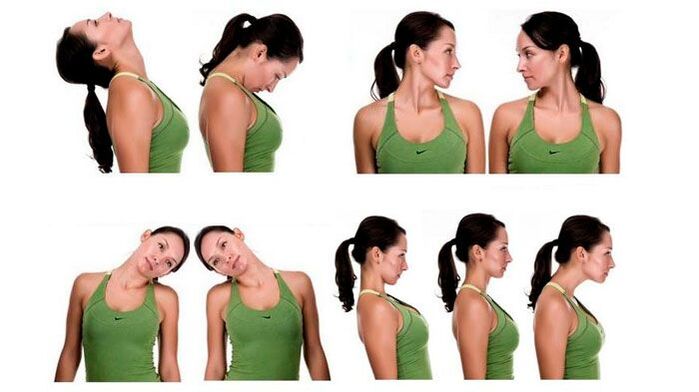
If a person has cervical osteochondrosis, every dayexercise,developed for the treatment of this disease, will help strengthen the muscular corset, which means - to reduce the load on the cervical spine. Exercise therapy is indicated at all stages of the disease, as well as as a preventive measure. During an exacerbation, a set of exercises should be performed with caution.
Special training for the treatment of osteochondrosis of the cervical spine:
- head turned to the side;
- head tilted forward and backward;
- raise the shoulder with a relaxed or fixed hand, holding it in this position for 15-20 seconds;
- flexor bend tension and neck extensor with stationary head position.
Exercises must be repeated 5-7 times. Lesson duration is 15–20 minutes.
Surgical intervention
If there is no positive effect after conservative treatment for 6 months, spinal fusion may be indicated. This procedure aims to paralyze the affected vertebral segment. These include removal of the intervertebral disc, decompression of nerve roots and placement of implants or the creation of a physiological height of the disc space. This operation has many contraindications and side effects. For example, spinal fusion can cause vertebral deformities. That is why surgical intervention is indicated only in extreme cases.
Nutrition and lifestyle
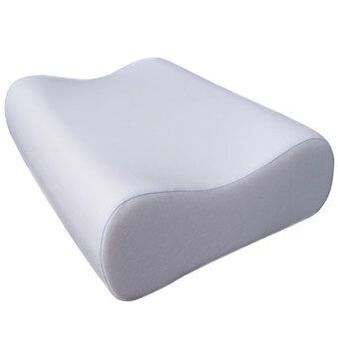
After surgical treatment of cervical osteochondrosis, at the time of initial recovery, wearing a fitting collar is required. During conservative treatment and at the time of final recovery, a diet rich in calcium and vitamins, correction of habitual posture and posture in general, a set of daily therapeutic exercises for the neck, orthopedic pillows are recommended.
Treatment of cervical osteochondrosis at home
If you are diagnosed with cervical osteochondrosis and its symptoms, and you want to undergohome treatment,it should be remembered that such independent interventions can only be performed in conjunction with procedures prescribed by a specialist.
Some experts recommend usingorthopedic pillowswith cervical osteochondrosis, and use warming agents such as pepper plasters, mustard plasters and alcohol compresses. According to others, just specialexercisefor treatment andprevention. . .
You can also use the help of traditional medicine recipes, which are based on the use of honey-potato compresses and bandages with natural ingredients. More information about the tool can be found on the Internet. However, only an experienced and highly qualified physician can diagnose cervixothoraic osteochondrosis, identify symptoms and prescribe the most effective treatment.
Preventive measures for cervical osteochondrosis

An examination by the attending physician is required once a year. A course of shock wave therapy may be prescribed. Hypothermia and infectious diseases, prolonged work at the computer in one position should be avoided. If you’re on a long plane or bus, use a neck support pillow to help reduce muscle tension and prevent congestion. For daily sleep, use a special orthopedic pillow that ensures proper head position.

















































